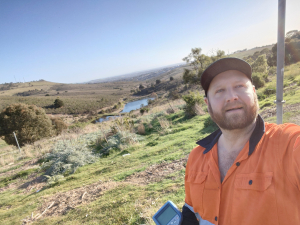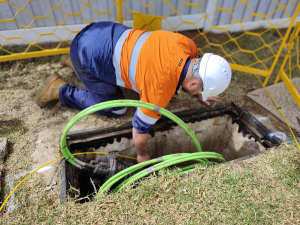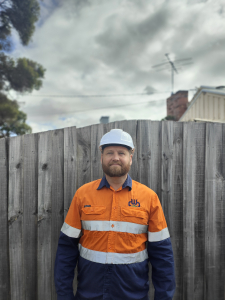“Gett ing certified was a validation of my learning, skills and also a key step in my career progression. It signifies my dedication to upholding the industry’s stringent standards and DBYD Certification’s rigorous assessments,” Charlie affirmed.
ing certified was a validation of my learning, skills and also a key step in my career progression. It signifies my dedication to upholding the industry’s stringent standards and DBYD Certification’s rigorous assessments,” Charlie affirmed.
Reflecting on the certification process, Charlie acknowledged facing two significant challenges. Overcoming test anxiety was crucial, necessitating practice until procedures became second nature. Slowing down during the practical assessment and approaching it methodically boosted confidence, allowing a comprehensive display of acquired skills and knowledge.
“Learning to distinguish Telstra cables posed a notable hurdle. Once I referred to a Telstra cable guide online, decoding acronyms that I was confused by, it became clear, resolving any ongoing issues,” Charlie recounted.
Expressing passion for the role, Charlie highlighted the appeal of service locating was that it matches his curious nature. He shared how eager he is in learning how things work – from how the locating equipment works through to how the various utility systems work.
 Having the confidence in advising a client on where the underground services are located, by marking them correctly, is a critical component to mitigate risk before ground-disturbing.
Having the confidence in advising a client on where the underground services are located, by marking them correctly, is a critical component to mitigate risk before ground-disturbing.
Charlie recounts an incident at a new estate that exposed one client’s disregard for marked services: “I had a job locating all the services in the nature strips of a new estate so they could maintain a safe 1.5 m from services when planting trees. When I arrived on day 2 of the job, the mini excavator was already at work digging holes for the trees, directly over the power and gas lines I had already marked, occasionally ripping up the marker take for the LV. After speaking with the site manager, it became apparent that they were planting trees according to ‘the plan’ regardless of the actual position of services. I had marked the service clearly, provided relevant information on clearances required for services and made sure I kept notes on all of it. It was a lesson for me that as a locator I can do the locations and provide information, but ultimately, it is up to the client to use that information and determine the next steps. This was a great reminder to take photos and notes and to get the job sheet signed off to CYA.”
For those aspiring to enter the field of service locating, Charlie offers practical advice. “Get comfortable reading complex Telstra plans, practice the locate process until it becomes habit, and look for opportunities to locate less-common services,” he suggests.
“I would go for a walk to grab a coffee and I would look for all the pits, valves and connection points. Then I would go over in my head the method of connection I would use, doing a 360 sweep, how I would trouble shoot a poor signal.” Creating these repeatable processes allowed Charlie to become the confident Certified Locator he is today.
Proactive learning, a curiosity for problem solving and a solid process will help you on your path to becoming Certified.

If you’re interested in connecting with Charlie or DWB Engineering, feel free to reach out:
Connect with DWB Engineering on LinkedIn.
Find out more about becoming a Certified Locator here.
To contact a Certified Locator for your next project search here.